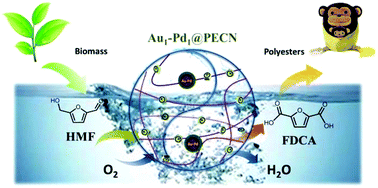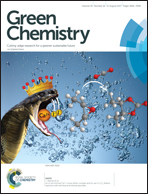Hydrophilic mesoporous poly(ionic liquid)-supported Au–Pd alloy nanoparticles towards aerobic oxidation of 5-hydroxymethylfurfural to 2,5-furandicarboxylic acid under mild conditions†
Abstract
Design of stable high-performance heterogeneous catalysts has become crucial for efficient catalytic conversion of renewable biomass into high value-added chemicals. Noble metal alloy nanoparticles (NPs) are of great interest due to their unique tunable structures and high activity. In this study, Au–Pd alloy NPs supported on hydrophilic mesoporous poly(ionic liquid) (MPIL) exhibited encouragingly high performance in the aerobic oxidation of biomass-derived 5-hydroxymethylfurfural (HMF) to 2,5-furandicarboxylic acid (FDCA) in water under mild conditions. Nearly complete conversion of HMF is attained at a low temperature of 90 °C under atmospheric O2, resulting in 99% FDCA yield and high turnover number (TON) of up to 350. After reaction, the catalyst can be facilely recovered and reused with stable activity. Surface wettability plays a dominant role in the oxidation of HMF to FDCA, and synergistic alloy effect accounts for high activity. The results also show that MPILs are a promising support platform to achieve stable and efficient metal NPs through task-specific design of functional monomers.



 Please wait while we load your content...
Please wait while we load your content...